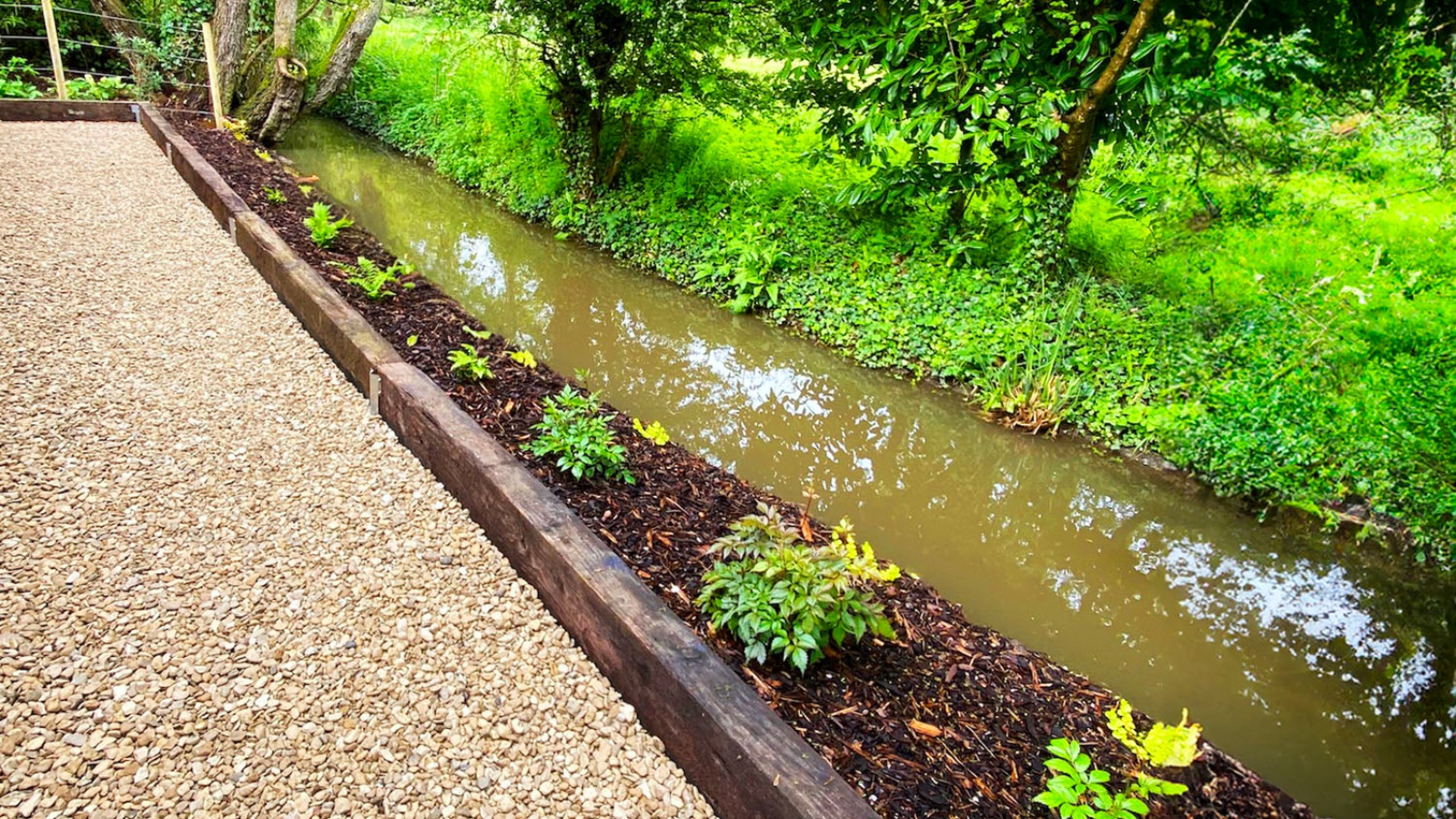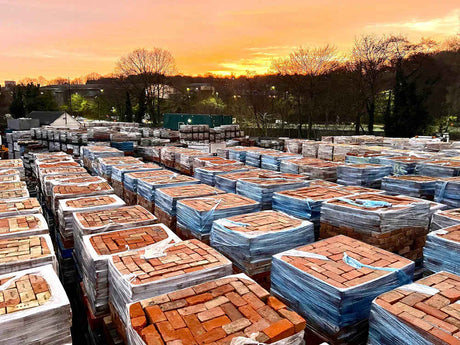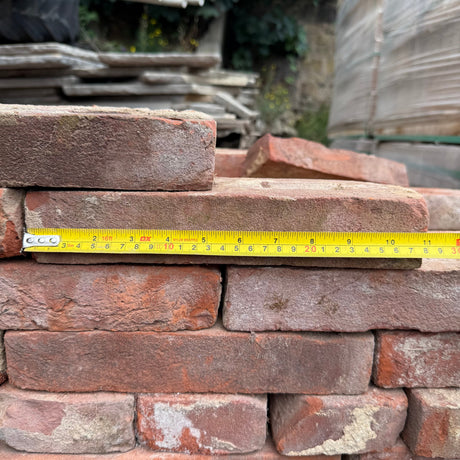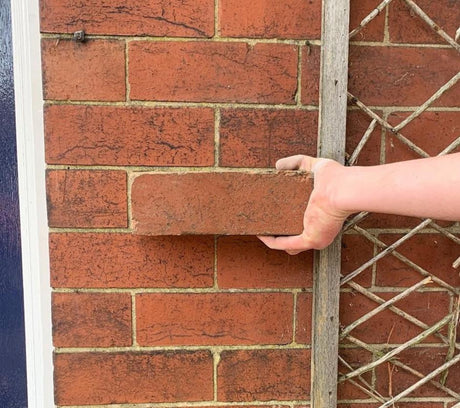Creating a stunning garden requires more than just planting your favourite flowers. Many people face the challenge of keeping their garden neat and well-defined. One effective solution is using railway sleepers as garden edging.
These sleepers can instantly elevate the look of any outdoor space, adding a rustic charm while clearly marking out different areas.
Railway sleepers are large, sturdy beams traditionally used to support railroad tracks. When repurposed in the garden, they offer an attractive and durable way to edge beds or create raised borders.
This blog will guide you through selecting the right materials and laying them correctly for long-lasting results. Ready to transform your garden? Let's get started!
What are Railway Sleepers and Why Use Railway sleepers as garden edging ?
Railway sleepers provide a robust and versatile solution for many landscaping projects, making them ideal for use in the garden. Traditionally used to support railway tracks, these sturdy blocks have found a new purpose in creating raised beds, borders, and edging that stand the test of time.
Their durability is unmatched by standard garden materials, offering a weather-resistant and heavy-duty option for those looking to add structure to their outdoor space.
Garden sleepers come in various types—wooden, concrete, and recycled plastic—each suited to different aesthetic tastes and functional requirements. They serve not just as practical elements but also enhance the visual appeal of gardens with their natural look when wooden or modern touch if opting for concrete or plastic options.
Using them in landscaping projects ensures longevity and adds an element of timeless design.
Choosing the right type of sleeper can transform your garden into a beautiful yet functional retreat.
Let's explore how you can lay railway sleepers to create stunning garden edging.
Understanding Railway Sleepers
Railway sleepers function as the firm base for railway tracks, tracing their origins to the early periods of railway transport. These timber sleepers are substantial, rectangular supports commonly crafted from wood, concrete, or steel.
Initially created to equally distribute load across the rails, these sleepers have found a secondary use in garden design and as other landscaping materials. For their sturdiness, adaptability, and visual charm, they are cherished by both homeowners and designers.
Introducing salvaged railway sleepers to your garden contributes to an intriguing visual element while also supporting sustainability efforts because it repurposes materials that would have been thrown away.
Whether right sleepers are utilised as a boundary for garden edges or as an element of a raised bed setup, these sleepers can dramatically impact the appearance and practicality of your outdoor area.
Let's continue to delve into the unique advantages they offer when incorporated into garden landscapes.
Benefits of Using Sleepers in the Garden
Sleepers add a robust aesthetic appeal to garden borders, making the space look well-structured and appealing. They serve as durable edging that neatly defines areas of the garden, from flower beds to paths, ensuring clear demarcation and improving overall garden design.
The versatility of sleepers allows architects and designers to create raised beds or retain walls that enhance the functionality of outdoor spaces. Their heavy-duty nature means they can withstand adverse weather conditions, securing soil in place and preventing erosion effectively.
Utilising former railway sleepers as garden edging in garden projects also promotes sustainable practices by repurposing reclaimed railway sleepers for edging and other landscaping materials needs. This approach supports environmental conservation efforts while providing a unique character to garden designs with their rustic charm.
For builders and homeowners looking for cost-effective but high-quality materials, recycled plastic sleepers offer an alternative that combines durability with low maintenance requirements.
These materials resist rotting, splintering, and infestation by pests like termites—key considerations for long-term outdoor use in creating timeless gardens that require minimal upkeep over the years.
Types of Garden Sleepers Available
Selecting the right type of garden sleeper is crucial for both aesthetic appeal and the longevity and sustainability of your garden design. Garden sleepers come in a variety of materials, each with unique benefits and considerations. This concise overview in table format is intended to assist architects, builders, contractors, interior designers, and homeowners in making an informed choice.
Each sleeper type has a specific role and contributes a distinct aesthetic to garden projects. Wooden sleepers are a timeless, flexible choice but might need more upkeep. Concrete sleepers are enduring and require little maintenance but might not integrate as well into natural surroundings, though they are well-suited for modern designs. Plastic and concrete sleepers also are an environmentally considerate option, but their cost and potential visual impact must be balanced against project goals. Finally, reclaimed railway sleepers provide charming rustic looks and a sense of history, with chemical treatments being a factor for careful consideration and application.

How to Lay Garden Sleepers for Edging?
Laying garden sleepers for edging creates a neat and durable border for your garden space. This guide will show you everything you need to know to using lay sleepers for lay garden sleepers depends and for lay garden sleepers and for using lay garden sleepers for edging effectively.
-
Plan your layout. Decide where you want the sleeper edging in your garden. Use a string line to mark the shape and length of your border.
-
Gather your tools and materials. You will need railway sleepers, spirit level, screws, saw, drill, shovel, wheelbarrow, and landscape fabric.
-
Dig a shallow trench. The trench should be slightly wider and the same depth as your sleepers.
-
Cut the sleepers to length if necessary. Measure twice and cut once using a saw.
-
Lay the first sleeper in place. Ensure it sits firmly on the ground.
-
Check for levelness with a spirit level. Adjust the sleeper by adding or removing soil underneath until it's perfectly level.
-
Secure the first sleeper with stakes or rebar if needed. Drive them into the ground on either side of the sleeper.
-
Place subsequent sleepers next to each other, checking levelness as you go.
-
Screw sleepers together at ends for longer borders using landscaping screws for stability.
-
Backfill any gaps behind the sleepers with soil to hold them firmly in place.
-
For corners, cut sleepers at a 45-degree angle to fit them neatly together.
-
Optionally, treat exposed wood surfaces with wood preservative to prolong their life.
Ensure each sleeper is securely placed and leveled accurately along your planned layout for a beautiful and long-lasting garden border.
Tools and Materials You’ll Need
Laying sleeper steps or borders requires the right tools and materials. This ensures your project lasts long and looks great in your garden.
-
Railway sleepers: Choose from hardwood, softwood, or reclaimed sleepers depending on your garden's aesthetic and budget.
-
Spirit level: Use this to ensure that each sleeper sits level on the ground and lines up neatly at the corners.
-
Rubber mallet: A must-have for securing sleepers into place without causing damage.
-
Screws and brackets: Ideal for securing two sleepers together firmly.
-
Drill with screw bits: You'll need this to pre-drill holes for screws when joining sleepers.
-
Saw: Necessary for cutting sleepers to your desired length; consider a handsaw or chainsaw depending on the thickness.
-
Measuring tape: Accuracy is key in making sure you cut the right length and lay the sleepers correctly.
-
Shovel: For digging trenches where you’ll lay the first sleeper or adjusting soil levels.
-
Sand or gravel: Provides a stable base for laying sleepers, especially important for retaining walls or raised garden beds.
-
Weed barrier fabric: Laying this under your sleeper border helps prevent weed growth while allowing water drainage.
-
Metal plates or steel rods (for securing): Use these if you prefer a more industrial look or need extra stability in sloped areas.
Each item plays a crucial role in getting those railway sleepers in place, creating durable and beautiful edging for your lawn or raised garden beds. Selecting the proper tools and materials will make laying railway sleepers for smaller garden projects simpler and help achieve that sought-after professional finish in your gardening projects.
Step-by-Step Guide for Laying garden Sleepers
Laying railway sleepers in your garden is a great DIY project. It adds an aesthetic charm and function to any outdoor space.
-
Decide where you want your sleepers border. This could be for a garden path, raised beds, or retaining walls.
-
Measure the length of the border. You will need this to know the number of sleepers to buy
-
Choose the right type of sleeper for your project. Options include new or reclaimed railway sleepers, wooden, concrete, or plastic ones.
-
Clear the area where you'll lay the sleepers. Remove any debris, weeds, or old plants.
-
Dig a shallow trench for the first sleeper. Make it slightly wider than the sleeper itself.
-
Use a spirit level to ensure the trench bottom is flat and even.
-
Place the first sleeper into the trench gently. Use a rubber mallet if necessary to fit it snugly.
-
Check that this first sleeper is level using a spirit level again.
-
Fill any gaps beneath with soil to stable it if need be.
-
Continue laying each sleeper next to one another along your marked line.
-
Ensure each one is firmly placed against its neighbour with no gaps.
-
Secure the sleepers together for durability using screws and brackets or steel rod pins through pre-drilled holes.
-
If building raised beds or securing against a slope, consider reinforcing behind with wooden posts or spikes for extra stability.
-
Once all sleepers are laid and secured, fill with topsoil ready for planting if making raised beds or borders.
This process allows architects and builders to create aesthetically pleasing yet functional forest garden features with ease—using materials like softwood sleepers that add natural beauty to forest garden while being environmentally friendly too.
Ensuring a Level Edge with Spirit Level
After mastering the step-by-step guide to lay railway sleepers, it's time to focus on achieving a level edge. A spirit level becomes your essential tool here. You’ll want to make sure each sleeper sits perfectly horizontal before securing them into place.
This is crucial for both aesthetic and functional reasons. A well-levelled sleeper ensures stability and adds a professional touch to your garden design.
Place the spirit level on top of each sleeper as you position them onto the soil or base layer. Check frequently that bubbles settle in the middle, indicating evenness. Minor adjustments might be necessary as you're laying down each piece, using either sand under low areas or gently tapping high spots with a rubber mallet.
This precision guarantees that your finished project will look great and last longer, supporting whatever decorative ideas or plants you choose to add next in making a garden standout.

What are the Best Sleepers to Use for Garden Edging?
New and reclaimed railway sleepers are top choices for garden edging. New sleepers, free from wear or chemical treatments, offer a clean look and uniform size, making them great for modern gardens.
Reclaimed timber and railway sleepers add character with their weathered appearance, ideal for rustic designs. Both wooden and concrete and timber sleepers are popular; wood and timber brings natural warmth while concrete and timber delivers durability against rot and pests.
Choosing the right sleeper depends on your garden's style and practical needs. For those prioritising eco-friendliness, recycled plastic sleepers provide an alternative that withstands moisture without decaying.
Wooden options require treatment to extend their life when in contact with soil.
Selecting the right type of sleeper can lead to a stunning transformation of your garden edge, making it both a functional border and an aesthetic feature.
Next up we'll explore secure methods to hold these sleepers together, ensuring they provide solid surface long-lasting support to your edging design.
New vs Reclaimed Railway Sleepers
Choosing between new and reclaimed railway sleepers for garden edging hinges on several variables including aesthetics, budget, and environmental concerns. Both have unique attributes suitable for different projects.
Selecting the right type of sleeper for garden edging involves evaluating these factors. New sleepers offer a contemporary feel, ideal for modern garden landscapes. Reclaimed sleepers, celebrated for their character and history, fit seamlessly into traditional or rustic gardens. Each choice supports green landscaping by either utilising a recycled material or, in the case of new sleepers, often sourced from sustainable forestry. Cost-wise, reclaimed sleepers might be lighter on the pocket, but it's crucial to check the quality and suitability, especially regarding chemical treatments, for your specific garden needs. Durability spans widely across both options, influenced heavily by treatment and environmental conditions. Ultimately, whether aiming for a sleek, uniform edge or a charming, rugged border, the selection between new and reclaimed railway sleepers will significantly impact the aesthetic and environmental footprint of your garden project.
Wooden, Concrete, and Plastic Sleepers
Selecting the appropriate type of garden sleeper used for garden edging depends on various factors including durability, aesthetic preference, and environmental considerations. Here’s a concise comparison between wooden, concrete, and plastic garden sleepers to guide architects, builders, contractors, interior designers, and homeowners in making an informed choice.
Considering these options ensures a well-informed decision for creating durable and aesthetically pleasing sleepers for garden edging throughout. Next, we'll explore how to securely join these sleepers for a robust garden border.
Choosing the Right Sleepers for Your Garden
The choice of garden sleepers depends mostly on the type of garden you’re looking to create. For those using railway lay sleepers for garden or in the garden, there's a debate between new versus reclaimed timber laying garden and how many sleepers are used.
New ones ensure uniformity and often come treated for longevity, making them suitable for a modern look for your garden. Reclaimed sleepers offer an eco-friendly option with unique character but require treatment to make sure they're safe from pests and decay.
Wooden, concrete, and plastic sleepers each have their place depending on your project's needs. Wooden options like oak are prized for their natural beauty and strength, ideal for beds or retaining walls where aesthetics are key.
Concrete offers unmatched durability and minimal upkeep, perfect where structural integrity is paramount. Plastic versions weigh less and resist rot without chemical treatments, fitting well in child-friendly spaces or areas with moisture issues.
Next comes securing these choices effectively to build a durable border.

How to Secure Sleepers Together for a Durable Border?
Securing one or two sleepers together forms a strong border that lasts for years. You're creating something durable and visually appealing when you do this right. Here's how to ensure your railway sleeper edging remains intact:
-
Choose the right type of screws - Use metal screws specifically designed for outdoor use. They resist rust and hold sleepers tight.
-
Drill pilot holes - Before screwing, drill pilot holes into the sleepers. This makes it easier to insert screws and prevents the wood from splitting.
-
Use metal brackets for corners - For a neat finish at corners, metal plates or brackets offer extra stability. Secure them on the inside to keep them hidden.
-
Place wooden posts or spikes behind the sleepers - Installing a wooden post or spike behind each sleeper provides additional support, especially for tall borders.
-
Lay sleepers horizontally and secure them - When laying sleepers flat, place one on top of another and screw them together for height.
-
Apply wood preservation treatments - Treat exposed or cut surfaces with a wood preservative to prevent rot and extend their life.
-
Fasten with rebars for extra strength - Drive steel rebars through pre-drilled holes in the sleepers into the ground below for rigid anchorage.
-
Check alignment with a spirit level - Ensure they’re perfectly horizontal by using a spirit level as you go along.
-
Consider using concrete as a foundation - For ultimate durability, lay a thin strip of concrete where you’ll place your first row of sleepers.
-
Fill gaps with natural rubber or mulch - To prevent weeds, fill spaces between and around sleepers with mulch or rubber chips.
Moving forward ensures your garden features such as raised beds complement this sturdy framework.
Methods to Secure Sleepers
Securing sleepers accurately is paramount in ensuring the longevity of your garden borders. The correct methods guarantee resilience and also promote safety within the garden structure.
-
Deploy metal plates and brackets: They aid in uniting two or more sleepers. It is suggested to drill holes through the sleepers, then bind them using the plates for increased sturdiness.
-
Insert rebars through sleepers: For a stable base, locate the railway tie in your preferred place and bore vertical holes through it. Pound long sections of rebar down through these holes into the ground below.
-
Utilise wooden dowels for a natural appearance: Corresponding to the rebar method, but suitable for those who favour wood over metal. Bore holes and pound wooden dowels through the sleepers into the soil.
-
Incorporate sleeper screws made for timber construction: These are substantial, resilient screws that can pull and secure sleepers firmly together. It is suggested to pre-drill guide holes to facilitate screwing and avert splitting the wood.
-
Installation of a concrete base: For ultimate steadiness, position your sleepers on a strip of concrete. This method is optimal for the construction of raised beds or the need for a definitively level border.
-
Merge with brickwork for extra support and visual attractiveness: Position bricks at specific points along the back of the sleeper edging to offer additional structural support and improve visual appeal in your garden design.
Knowing how to safely secure railway ties significantly benefits the lifespan and aesthetics of your raised gardens forest garden, and landscape. Next, we will explore how these adaptable materials can revolutionise building raised gardens, beds, gardens, beds and garden beds.

Using Screws and Brackets
Transitioning from broad strategies to fix sleepers timber edging, we concentrate on the particulars of employing screws and brackets. This method is fundamental in safeguarding your garden's sleeper timber edging, keeping it solid and enduring over desired length of time.
To implement this, you require metal plates and prolonged screws suitable for outdoor use, preventing any rust that could debilitate the connection between the sleepers.
A secure garden begins with firmly anchored foundations.
Initially, position your railway sleepers to the location you're planning for your border or raised bed. Once situated, bore guiding holes through both the metal plate and steel rod pins the sleeper to direct the screws precisely.
Using resilient screws ensures strong bond when they permeate deeply to keep solid surface and everything tightly bound. Brackets become significant at corners or junctions where extra support and stability is needed to retain the structure's form.
The right equipment selection is crucial for creating a durable garden feature that withstands elements while preserving its visual allure for years.
Securing Sleepers with Rebars
Securing sleepers with rebars ensures a durable garden border. You need to start by drilling holes through the sleepers. After that, drive the rebars into the ground through these holes.
This method tightly secures each sleeper in place.
Using metal plates isn't necessary when you opt for rebars. This process creates a strong framework for your garden borders or raised beds. It’s a direct and efficient way to maintain the structure of your project over time.

Can Railway Sleepers be Used for Raised Garden Beds?
Railway sleepers present a strong and visually pleasing alternative for constructing raised garden beds. They are frequently chosen by architects, builders, contractors, interior designers, and homeowners because of their longevity and user-friendliness.
In the face of soil pressure resulting from raised-bed gardening projects, railway sleepers remain unbending and unbroken, making them an optimal selection for those wanting to create a garden with structure and style.
Building these beds necessitates laying the sleepers flat or stacking them to reach the preferred height. It's necessary to fasten them together using metal plates, screws or rebars, ensuring stability.
This technique delivers a stable base for your plants while concurrently lending a touch of artistry to your garden layout. Thoughtful laying out in terms of positioning and securing guarantees that these arrangements endure for a considerable amount of time, making them a wise commitment for enhancing outdoor areas.
Designing Raised Garden Beds with Sleepers
Creating elevated garden beds with sleepers empowers architects, builders, contractors, interior designers, and homeowners to imaginatively utilise space while increasing visual charm.
The approach begins with choosing the most convenient type of natural timber sleepers for your venture; from repurposed railway ties for an antique feel or new lumber for a neater finish. Through utilising timber sleepers first, you metamorphose these simple railway components into practical and trendy elevated beds that can accommodate any garden style.
Erecting elevated beds involves arranging the sleepers in rectangular or square shapes and binding them tightly with metal plates or screws for longevity. Utilising a spirit level during construction to sustain a steady surface across the sleepers' top is crucial.
This stage ensures that your elevated beds appear professional and operate efficiently for everything from vegetable plots to flower beds. With thoughtful organisation and execution, elevated garden beds made from sleepers evolve into both a prominent element in landscape structure and a functional attribute for home gardening admirers.
Construction Tips for Raised Beds
Creating raised beds with railway sleepers adds both functionality and aesthetic appeal to any garden. Using sleepers for this purpose allows you to make a garden more structured and accessible. Here are some tips to ensure your raised beds stand the test of time and bring beauty to your outdoor space.
-
Choose the right type of sleepers for your garden. Opt for new, treated sleepers to avoid chemicals leaching into the soil.
-
Measure the area where you're building the raised bed carefully. This ensures you buy the correct number of sleepers.
-
Lay down a weed-proof membrane before starting to lay your sleepers. This step prevents unwanted growth under your bed.
-
If you’re using wooden sleepers, apply a wood preservative on all sides before installation.
-
Use a spirit level to ensure they're perfectly horizontal as you lay each sleeper.
-
Secure the sleepers together at corners using metal plates or angle brackets for stability.
-
If your design is taller, involving one or two sleepers stacked, secure them together with long screws or rebars driven into the ground through pre-drilled holes.
-
Fill the inside of your raised bed with high-quality topsoil mixed with organic compost to promote healthy plant growth.
-
Consider installing internal support beams if making wide or long raised beds, preventing outward pressure from splitting the sleepers.
-
Finally, regularly inspect your sleeper edges and replace any that show signs of rot or damage over time.
These steps help you create durable and attractive raised beds that make gardening easier and enhance your outdoor space's overall look and feel.

Maintaining and Caring for Your Raised Beds
After building your elevated gardens with sleepers, it's necessary to concentrate on their maintenance for long-term use. Examine the sleepers on a regular basis for any signs of wear or decay.
If you've employed wooden sleepers, provide them with an annual treatment of a wood preservative to protect against moisture and pests. This procedure extends their usefulness and helps maintain a neat garden for more sleepers.
For elevated gardens constructed with railway sleepers, make sure an adequate drainage system is implemented to avoid water build-up, which could negatively affect the plants and speed up the wood's degradation.
Regularly removing weeds and ensuring that metal fixtures stay secure and free of rust are uncomplicated yet productive methods for maintaining your raised beds in an optimal state for many years.
How to Add Finishing Touches to Your Sleeper Edging?
Adding finishing touches to your sleeper edging transforms your garden borders from simple to spectacular. A well-finished edge gives your outdoor space a polished look.
-
Fill gaps with soil: Start by filling any gaps between your sleepers with soil. This secures them further and prepares the ground for planting.
-
Plant flowers or shrubs: Choose plants that complement the height and colour of your sleepers. You’re building not just a border, but a flourishing garden edge.
-
Use metal plates: Secure the corners and joints of sleepers with metal plates for added stability.
-
Apply wood treatment: Protect wooden sleepers from weather damage by applying a wood preservative.
-
Level the topsoil: Ensure the soil is levelled alongside the sleeper edging to prevent water pooling using a spirit level to ensure they’re even.
-
Add mulch: Applying mulch around plants helps retain moisture and keeps weeds at bay, enhancing sleeper longevity.
-
Decorative stones can be used next to sleeper edges to create an attractive visual contrast and aid in drainage.
-
Working with sleepers requires checking their alignment regularly, ensuring they form a straight line along your garden border.
-
Install lighting: Embedding solar lights along the sleeper edge can illuminate pathways while adding aesthetic appeal after dark.
-
Incorporating gravel or pebbles between sleepers adds texture and breaks monotony, offering a varied landscape design.
-
Regular maintenance involves checking for signs of wear or rot, especially in reclaimed railway sleepers, ensuring they remain in good condition.
-
Water features next to sleeper edgings introduce a tranquil element, turning gardens into peaceful retreats.
-
Finally, personalise your sleeper edges with creative painting or stencilling for a unique touch that reflects your style.
Adding Soil and Plants
After you start laying out the sleepers for your garden border, it’s time to start filling them with soil. Spread a generous layer of high-quality topsoil within the borders you've created. This soil acts as a fertile ground for any plants, flowers, or vegetables you plan to grow.
It’s crucial to ensure that this soil is nutrient-rich and well-draining to support plant health.
A garden requires patient labor and attention. Plants do not grow merely to satisfy ambitions or fulfill good intentions.
Once filled with soil, select plants that suit the light exposure and climate of your garden. Mixing perennials with annuals ensures year-round color new life and interest new life in your garden space.
If you’re laying out a vegetable patch, consider crop rotation to keep the soil healthy and reduce pests.
Next comes enhancing sleeper edges with decorative ideas for an attractive finish.
Decorative Ideas for Sleeper Borders
After setting the soil and planting your greens, it's the correct moment to uplift your garden's aesthetics with sleeper borders. For a visually pleasing effect, combine various types of sleepers available for edging.
Utilise new lay railway sleepers and lay sleepers for smaller garden projects, as well as reused ones to create a contrast that is visually pleasing. This technique adds character and also respects the versatility of the simple railway sleeper in garden design.
Include lighting within or along your sleeper borders for a charming effect after dusk. Arrange solar-powered lights to brighten walkways or spotlight particular plants. This enhances safety by demarcating edges when it's dark and also transforms your garden into a magical nighttime sanctuary.
DIY enthusiasts find the integration of these elements simple, making it an enjoyable weekend project that combines utility with style.
Maintaining the Look of Your Sleeper Edging
To keep your sleeper edging looking its best, timely maintenance is crucial. Start laying sleepers with a protective coat of wood preservative annually to guard against rot and weather damage. This step ensures the longevity of both new and reclaimed railway sleepers in your garden.
It's also vital to check for any signs of wear or deterioration regularly. If you spot any problems, addressing them quickly can prevent further damage.
Securing loose concrete sleepers for garden edging as soon as they start moving keeps the sleepers for garden edging more firm and functional. For wooden part sleepers for garden edging, replacing damaged sections might be necessary over time due to natural decay or insect infestation.
Ensure that replacements match the existing structure to maintain a coherent look throughout the garden border. Adopting these care practices will help preserve the aesthetic appeal and structural integrity of your sleeper edging for years to come.
Conclusion
Crafting garden borders with railway sleeper edging transforms spaces. You learned about the types, installation, and securing methods of lay sleepers for garden side. The easy steps ensure anyone can create stunning garden edges.
Have you thought about using the number of sleepers using this technique will enhance your landscaping? Sleepers offer beauty plus functionality to gardens. Discover more ways to use sleepers in your outdoor designs.
Let this guide inspire your next garden project.








